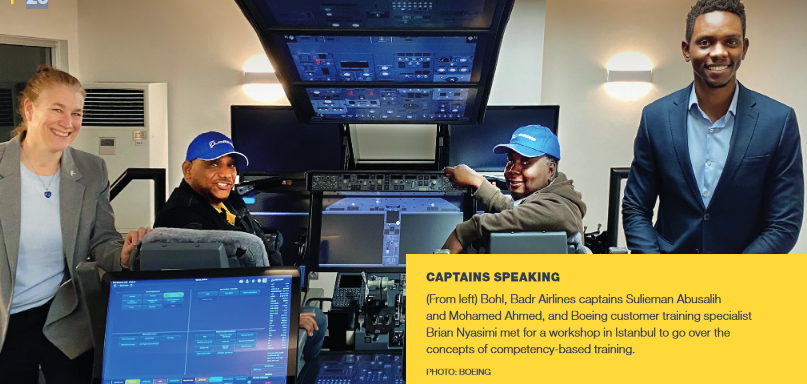More Show, Less Tell for Pilots
Following guidance set forth by the International Civil Aviation Organization,Boeing developed a CBTA program that standardizes pilot training to enhance the safety of air travel. Since early 2020, Boeing has worked with airline customers, pilot unions and regulatory authorities to create an immersive training curriculum, certify dozens of instructors and provide access to high-tech training tools at campuses around the world.
Each training session is grounded in relevant data, and every effort is made to enhance the learning experience for pilot trainees who are earning their type ratings and qualifications to fly Boeing airplanes.
With continuous advances in airplane technologies, pilots not only need technical instruction on how to fly an airplane, but also training that enhances their skills in problem-solving and decision-making, situation awareness, communication, leadership, teamwork and workload management. Industry has turned to CBTA programs as a way to impart the core competencies that complement and maximize the technical knowledge pilots have of their airplanes.
Once inside high-fidelity full-flight simulators, pilot trainees interact with their instructors and examiners — and sometimes their regulatory authorities — in an environment that is identical to an actual airplane flight deck. This realistic platform enables the trainees to work through real-world scenarios, which are similar to task-based training approaches, as they hone their competencies and behaviors as pilots.
From their jump seat in the simulator, instructors observe and record the trainee’s behaviors, decisions and interactions. As they watch the trainee perform the various maneuvers, they are not lecturing or directing the trainee’s actions. They are taking notes, offering guidance and assessing the pilot’s behaviors, preparing for the conversations and feedback sessions thatwill follow.
Through this observation, facilitation and dialogue that are the hallmarks of CBTA, the examiners assess the pilot’s behaviors and consistently rate their proficiencies in teamwork, communication, decision-making and crew management.
As Kieffer explains it, instructors are transitioning from lecturing to moderating training briefings and guiding students’ learning. “Instead of telling the pilots what to do step by step, I ask them to show me what they know already. That allows me to see their experience level, then shape the training accordingly.”
Airplane operators are working to establish individual CBTA programs, but there is no global standard for instruction, including for how to analyze streams of airplane data and flight statistics or to meet the distinct requirements of various regulatory authorities.
Ultimately, airlines and regulators are responsible for determining pilot training requirements. But, as an airplane manufacturer, Boeing recognized its obligation to help develop a comprehensive and standardized training package that would strengthen safety through advancing Boeing’s training offerings and serving operators worldwide.
“We’re working with operators to identify, develop and assess the competencies pilots need in order to safely operate today’s airplanes,” said Lacey Pittman, vice president of Boeing’s Global Aerospace Safety Initiative. “Beyond knowing the technical details of an aircraft, pilots are learning to manage and mitigate the most
prevalent threats and errors, those real-world threats that we know exist based on pilot feedback, operational data and training observations.
“By partnering with our operators and with global regulatory authorities tostrengthen our baseline training, together we are raising the bar on aerospace safety,” said Pittman.

Data Points:
Working With Pilots and Regulators To Build CBTA
When Boeing began to build CBTA methods into its training, its Learning Design team knew the curriculum had to be rooted in facts, data and hard evidence. The team combined industry data on airplane specifications with
reporting by pilot unions, airlines, third-party observers and regulatory authorities.
Curriculum specialists then designed the courses for delivery across multiple platforms, from mobile, e-learning applications to flight training devices and full-flight simulators.
“As we started to develop the curriculum, we brought in customers and asked for their feedback,” said Mike Miller, who manages the Learning Design team.
“We partnered with multiple airlines to identify known operation hazards and analyze safety risks, and we found that the flight operations data is really what makes this work.”
In 2020, Boeing welcomed Brazil’s GOL Linhas Aéreas Inteligentes (GOL Intelligent Airlines) as an early partner in developing the CBTA curriculum.
GOL worked through one of the first CBTA small group tryouts with the Learning Design team, and GOL was one of the first operators to have pilots achieve a type rating for the 737 MAX, certifying them to fly the aircraft.
“ By partnering with our operators and with global regulatory authorities to strengthen our baseline training, together we are raising the bar on aerospace safety.”
LACEY PITTMAN, VICE PRESIDENT OF BOEING’S GLOBAL AEROSPACE SAFETY INITIATIVE
“ We partnered with multiple airlines to identify known operation hazards and analyze safety risks, and we found that the flight operations data is really what makes this work.”
MIKE MILLER, MANAGER OF THE LEARNING DESIGN TEAM 22 IQ Training TEAM EFFORT
We learned a lot from GOL as we worked with the airline, their pilot union and Brazil’s National Civil Aviation Agency,” said Christine Bohl, who leads Boeing’s efforts to introduce CBTA to operators. The team met with
more than 70 customers from 45 countries in 2022 as Boeing expanded the training worldwide.
“GOL offered us extensive safety data analytics and flight operations data, and we were able to specialize our training offerings based on that information.”
The evidence-based training approach is a key strength of the CBTA program. Multiple data sources inform both the curriculum design and training customizations:
Airplane
The flight data recorder monitors details such as altitude, airspeed and heading. The cockpit voice recorder captures radio transmissions and sounds in the flight deck, such as the pilots’ voices and engine noises.
Pilots
In the U.S., self-reporting of safety events is voluntary and confidential through the Federal Aviation Administration’s Aviation Safety Action Program. As pilots speak up and report issues, analysts study what
happened, rather than identify who made a mistake.
Observers
This includes anyone who rides in the jump seat and observes the flight crew, including maintainers, trainers, check pilots and peers offering line operations safety assessments.
Other Parties
Air traffic controllers, government regulatory authorities, airplane mechanics, dispatchers and others on the ground
provide data to support CBTA development. Detailed flight information from Automatic Dependent Surveillance-
Broadcast data is another source of information for CBTA.
“Data can tell you a lot, not only about the airplane’s performance, but also the effects of human factors, like how well a crew communicates and balances workload and how pilots make their decisions,” said Chris Broom, vice president of Commercial Training Solutions for Boeing Global Services.
Class of Their Own: Enhancing the Training Experience
CBTA changes three things about pilot training — the instructor’s techniques, the student’s learning experience, and the tools and technologies at each training campus, both physical and virtual.
Just a few months after the FAA and the European Union Aviation Safety Agency approved the CBTA curriculum, Boeing began to offer the training around the world.
“If the operators can’t come to us, we go to them or bring them to us,” said Broom.
Since March 2022, dozens of operators have expressed interest in adopting the CBTA approach. Boeing has welcomed regulators, operators and pilots to its training campuses for dozens of workshops, webinars and information sessions.
Through hundreds of instruction sessions, operators have received the basic materials needed to begin to implement competency-based training right away.
There are multiple e-learning opportunities too. Cloud-based videos provide some instruction, and a mobile Virtual Procedures Trainer provides visual and audible context for students who need to gain familiarity with select
airplanes. Pilots can access the procedures on select electronic devices, which enables a customized, progressive learning experience.
With more than 40 certified CBTA instructors, Miller said it’s the instructors who make the difference.
“They are trained observers,” said Miller. Instructors recognize when a trainee is not demonstrating competency, perhaps lacking leadership or using poor communication skills, Miller explained. Training can be adjusted, based
on existing evidence for that competency.
“These instructors know how to assess pilot trainees consistently, and they know there’s always room for improvement, regardless of the pilot’s level of experience,” Miller said.

Show Me What You Know: Shifting From Lecturing to Facilitated Learning
The move to CBTA means the role of the training instructor has evolved. “Competency-based training is a huge step forward in how we train future pilots,” said Kieffer, the training center examiner.
“I can go back almost 40 years to when I learned how to fly, and back through the decades when my birth father learned to fly and when his father learned to fly. That’s three generations of pilots who received and conducted
training through traditional instructor-led lectures.
“CBTA is definitely a new way of teaching and instructing,” she said. “We are learning, excelling and balancing how to be both a facilitator and an instructor.
It doesn’t happen overnight, but it’s exciting to be a part of the evolution. “As pilots grasp the behaviors that lead to good decision-making, effective communication and efficient workload management, they will develop those
behaviors and become more competent, safer pilots,” said Kieffer.
Source: Boeing









Be the first to comment on "Pilot training with more show, less tell"